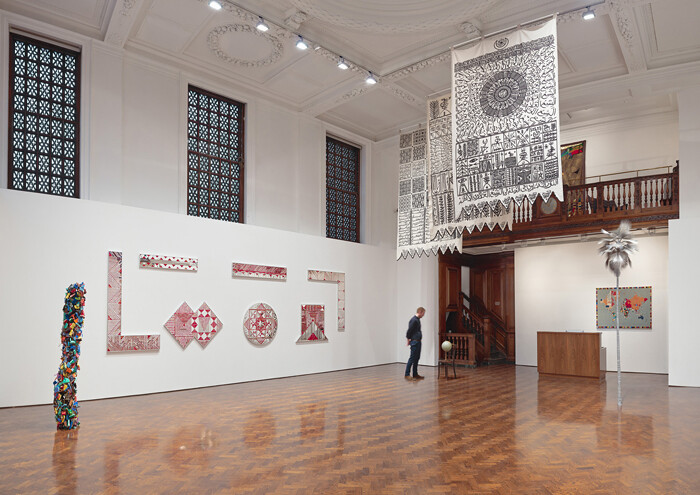Hauser & Wirth opened its latest show in its flagship London location at 196 Piccadilly with a new exhibit entitled “Trade Routes.” The exhibition comes at a time when recent iterations of major international exhibitions from the likes of Documenta to the Gwangju Biennale, Istanbul Biennial, and Sharjah Biennial have taken an ever more geographically de-centered approach to forming their artist lists. The notion of the Global South as a curatorial starting point has seen an ever-increasing diversity of artist names on major exhibition calendars, and has given rise to such initiatives as the New Museum’s Museum as Hub, an international network of small and large institutional partners collectively adopting a shared theme for examination. Likewise, the Tate Modern has continued to use its Project Space (formerly known as the Level 2 Gallery) to engage in collaborations with small- to medium-sized international art spaces rarely profiled in hegemonic institutions. Most recently, Lisson Gallery furthered its reach specifically into North Africa with its Cairo-based collaboration, “The Magic of the State” with the project space Beirut, and its recent appointment of Nayrouz Tatanaki (a British-Libyan specialist in Modern Arab, Turkish, and Iranian Art) as an Associate Director.
Looking to the East, whether it be the Middle East, Central Asia, South Asia, or the Far East, undoubtedly makes for good business. “Trade Routes” makes a point of emphasizing that it includes work from Africa, China, Europe, India, and the Middle East. Collectively, the fifteen exhibited artists are tasked with exploring “where the trade routes stand in today’s globalized society” (or so the press release tells us). Perhaps it would be more apt to re-articulate the term “globalized society” into what Anthony Downey declares to be a “globalized cultural economy.”1 In this scenario, the integrated network of diplomatic and financial agents function as key actors in global taste brokering, yielding their influence with the wealth that they bequeath to museums, foundations, funds, and personal collections.
As such, it is ironic (or arguably strategic) that Hauser & Wirth, well aware of the current inter-linked market assimilation, would soften the potential for brash political imagery by beckoning the nostalgic metaphor of the “trade route” to bookend a potted exhibition of contemporary works of largely non-Western art. (Non-Western here is defined both in terms of geographical origin of the artists and in terms of the formal approaches adopted by the exhibiting artists).
The exhibition begins with a gesture by German artist Bettina Pousttchi, whose photographic series Piccadilly Windows (2013) re-works images of timber-wood windows, intertwining what could be conceived as “Middle Eastern” architectural features into them. Rachid Koraïchi and Monir Farmanfarmaian also adapt what the gallery deems “traditional” Middle Eastern techniques. Dangling from the gallery’s ceiling are Koraïchi’s large tapestries, Les Maîtres Invisibles (The Invisible Masters): Ennafari (2008), which are covered in Arabic calligraphy supposedly detailing the biographies of Islamic spiritual figures.
The highlight for me was the work Mendeel Um A7mad (NxIxSxM) (2012), an HD single-channel video by New York-based artists Fatima Al-Qadiri and Khalid al Gharaballi. Regular collaborators, in this video, the duo staged a Kuwaiti scene of women meeting for tea. Yet here the middle-aged women are played by a bevy of young men in drag who occupy a garish hotel ballroom, with the actors seated at an unsettling distance from each other. A pink box of tissues (manadeel) is placed alone at the center of the room, unreachable to the subjects who have come to congregate. Al-Qadiri and al Gharaballi’s queering of the familiar domestic Kuwaiti sphere raises urgent questions about how global cultural forms have begun to alter and shift traditional routines, and in particular those of Arab societies. What occurs when pop culture becomes incorporated and merged with the local? Does it foster more complex readings of personal identity as opposed to the stagnant stereotypes, which exist in the shadow of postcolonial theory, or does it merely allow a space for irony (with all of its self-referential qualities) to manifest?
Elsewhere, and on a similar thematic note, Adel Abidin—who has recently come to increasing prominence—is represented here by Three Love Songs (2010), a three-channel video work just under nine minutes in length, which depicts a group of blonde women singing sultry songs in Arabic. The surprising “reveal,” however, is that the songs are in fact an homage to the late Iraqi leader, Saddam Hussein. “Trade Routes” also brought together works by the (ever-present) Egyptian artist Wael Shawky, along with pieces by Hassan Sharif and Subodh Gupta, only to jump on the Saudi-Arabian bandwagon by exhibiting the work of Maha Malluh, whose cassette tapes impressed into wooden baking trays, Food for Thought 11300 (2013), have become familiar fast food for many. (An earlier version of the work was exhibited during the 2012 Frieze week at Edge of Arabia’s painfully titled exhibition “#COME TOGETHER,” which occurred in East London’s Old Truman Brewery.)
As a construct, “Trade Routes” seems to encourage Hauser & Wirth to move beyond the confines of its largely Eurocentric artist portfolio. With a heavy focus on what can be dubbed the Middle East, the exhibition has thankfully disavowed the derivative “appropriation art” that has recently become the preserve of many European exhibitions of non-Western art. Still, as far as surveys of “trade routes” go, there was plenty more that could have been explored that far-too-often has been left for the viewers to construct in their imaginations.








